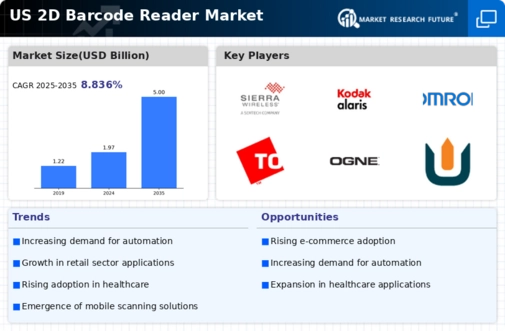Adoption of Mobile Payment Solutions
The rise of mobile payment solutions is significantly impacting the 2d barcode-reader market. As consumers increasingly opt for contactless payment methods, businesses are integrating barcode technology to facilitate seamless transactions. In 2025, mobile payment transactions in the US are projected to exceed $500 billion, highlighting the need for efficient scanning solutions. 2d barcode readers enable quick and accurate processing of mobile payments, enhancing the overall customer experience. This trend suggests that the 2d barcode-reader market will continue to grow as more retailers adopt mobile payment systems, seeking to provide convenience and speed to their customers.
Growth in E-commerce and Online Retail
The expansion of e-commerce and online retail is significantly influencing the 2d barcode-reader market. As online shopping continues to gain traction, businesses are increasingly relying on barcode technology to manage logistics and fulfill orders efficiently. In 2025, e-commerce sales in the US are expected to surpass $1 trillion, necessitating robust systems for order processing and inventory tracking. Barcode readers facilitate quick scanning of products, ensuring accurate order fulfillment and enhancing customer satisfaction. This trend indicates that the 2d barcode-reader market is likely to benefit from the ongoing growth in the e-commerce sector, as retailers seek to implement effective solutions to meet rising consumer demands.
Regulatory Compliance and Safety Standards
The 2d barcode-reader market is also influenced by stringent regulatory compliance and safety standards across various industries. Companies are required to adhere to specific guidelines regarding product labeling and tracking, particularly in sectors such as food and pharmaceuticals. In 2025, it is anticipated that compliance-related investments will reach $2 billion in the US, driving the demand for barcode technology. 2d barcode readers facilitate accurate labeling and tracking, ensuring that businesses meet regulatory requirements. This necessity for compliance is likely to propel growth in the 2d barcode-reader market, as organizations seek reliable solutions to maintain safety and quality standards.
Increased Focus on Supply Chain Transparency
The 2d barcode-reader market is being propelled by a growing emphasis on supply chain transparency. Consumers and businesses alike are demanding greater visibility into product origins and handling processes. This trend is prompting companies to adopt barcode technology to track products throughout the supply chain. In 2025, it is estimated that 70% of US consumers will prefer brands that provide detailed product information, including sourcing and handling. As a result, businesses are investing in 2d barcode readers to enhance traceability and accountability, thereby driving growth in the market. This focus on transparency is likely to shape the future of the 2d barcode-reader market, as companies strive to meet consumer expectations.
Rising Demand for Inventory Management Solutions
The 2D barcode-reader market is experiencing a notable surge in demand for efficient inventory management solutions. Retailers and warehouses are increasingly adopting these technologies to streamline operations and enhance accuracy. In 2025, the market for inventory management systems is projected to reach approximately $5 billion in the US, with barcode readers playing a pivotal role in this growth. The ability to quickly scan and track products reduces human error and improves stock visibility, which is crucial for businesses aiming to optimize their supply chains. As companies seek to improve operational efficiency, the integration of 2d barcode readers into inventory systems appears to be a key driver in the market.




















Leave a Comment